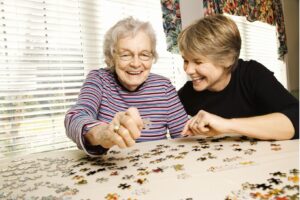From where I live, roughly 2,500 miles away, I transmit my love and care for my aging parents. The space between breeds some heartache and guilt, but when I can focus on the progressive solutions, at least, I’m not inflating those feelings unnecessarily. I’m certainly most helpful to my parents when I can tap into the more positive feelings and actions.
While it’s true that no technology can contain my love, the innovative tools designed for aging adults and their caregivers can expand my capacity for offering long-distance caregiving support to my aging parents. These tools also give me versatile ways to be in touch with and support my sister, their primary caregiver.
While the long-distance conditions could never be really ideal, I am able to recognize the silver lining: Compared with my sister, who spends at least some part of every day with my parents and is very wrapped up in their daily emotional and practical concerns, I am able to take a wider perspective. That distance and detachment can actually be very valuable as I am often able to recognize when the routines and care plans aren’t working as smoothly as they could be and when additional help is needed.
But from where I am—and for any caregiver who lives an hour or more away from their aging parents—that perspective depends on the clearest and fullest possible view of the situation. Here, technology can bridge the gap of distance, both in terms of the window onto their daily lives and care and in terms of transmitting my assistance creatively and efficiently. So, rather than focusing on the weight of heartache and guilt, I’m focusing on the routines that long-distance caregiving applications help to facilitate, and my sister and I have struck a vital balance in the shared care of our aging parents.
Organize Your Long-Distance Caregiving for Aging Parents with a Care Calendar
The first tool I want to introduce to you is an online care calendar because, for us, it exists at the center of all of our routines and other strategies. My family and I use Lotsa Helping Hands. It’s a free and easy-to-use calendar on the surface, and it opens up a much deeper source of community support.
My sister and I can both have behind-the-scenes access to the calendar as coordinators, and other family members and friends can be connected to receive updates and even to volunteer their support and services when specific needs arise. For example, we might post a request for help if someone is willing and able to take Mom to a doctor’s appointment on a specific date. Someone in the community can respond with their offer of help and then the calendar is updated, so there is no inconvenient overlap or miscommunication.
My sister has expressed very genuinely that having this in place takes a great weight off of her shoulders because she is not the only one involved and responsible. Even though I’m unable to volunteer for those in-person requests, I can keep a close eye on the calendar and anticipate when those needs arise. Occasionally, I’ll put out a call for a day of respite care or even help with dinner for an evening just to give my sister a break. I’m more likely to ask for that help for her than she is for herself.
A Wealth of Technology Solutions Support Long-Distance Caregiving
We’ve gathered a list of other technology solutions for caregivers that may or may not be helpful for your family. With all of these options, it’s best to download some different apps, pick up some different tools, play around with them, and then decide what works best for you and your care plan.
Video communication: Our runner-up for indispensable caregiving support is the ability to transcend simple phone conversations and communicate with video. This is the closest I can get to in-person interaction from a distance. I can get a sense of my aging parents’ emotional well-being directly, and I can offer personal, emotional express in return. Video conferencing applications include Skype on the computer or phone, Google Hangouts, and Facetime for Mac users.
This is one way that I can offer my sister respite. I schedule time on the shared calendar when I’m going to chat with my parents for a while, and she can go take care of other things, read a book, or get some rest. Because we can see each other through the computer, my parents and I will sometimes do chair exercises together—getting some extra cardio effort through laughter.
And, at least once a week, the whole family—my other siblings included—get on a video conference for a family meeting. We have dinner together and discuss how everything’s going with our caregiving strategies. All in all, video communication helps us all to stay accountable and emotionally aware. It also helps my parents to feel more included in their own course of care.
Telehealth monitoring: Each aging adult has different health needs, and current health monitoring technology can help you to stay on top of monitoring those needs. In a lot of cases, applications help them to manage these tasks on their own, expanding their opportunities for independence. But rest assured that the results of these evaluation episodes will be recorded and even stored in a place that you can access. Some apps even make the results of vitals monitoring available to medical professionals, so they have a long-range view of the individual’s status and can recognize any concerning results, including measures of blood pressure, heart rate, blood glucose, and sleep patterns. These types of apps can also help you to securely organize health history and current treatment and appointment information—to share among caregivers and with healthcare providers. Check out HealthVault from Microsoft and ask your loved one’s doctor about other opportunities for remote patient monitoring (RPM).
Medication management: Another tool that can help your aging parent feel more empowered and independent—or help a caregiver feel more organized—is an application that helps to keep track of medication dosages and even gives an alert when it’s time to take them. MediSafe acts as a pill reminder and tracker. The Tabtime Vibe is a standalone pill organizer with an alarm built in. Pill Pack is a revolutionary pharmacy subscription that does the organization for you and delivers easily accessible dosages to your door.
Meal planning and delivery: Plenty of services now make healthy food delivery and preparation very accessible. This is one way that I am easily able to support my parents and my sister from afar: I can manage grocery lists and have them delivered, so no one has to go out of their way to worry about those extra tasks. Here is a guide to finding local grocery delivery, shopping assistance, and ready-made meals.
Home safety monitoring: Nowadays, technology can keep track of so many details in the home. Applications can monitor your loved one’s movement and sleep patterns and even when they take a fall. They can alert you if someone leaves the stove on or the refrigerator door open. You can adjust the home climate control remotely and even lock the doors the same way. Lively is a great option for comprehensive safety monitoring.
Financial organization and protection: Another critical area of need for a lot of aging adults is help with financial accounts, budgets, and bills. Not to mention a lot of older adults fall victim to financial scams that target this vulnerable demographic. You can turn over management of your aging parents’ finances to a trustworthy service provider like Institute on Aging or a daily money manager. And resources like True Link Card can offer peace of mind around potential financial scams and predation.
With the rise of technology in our daily lives, privacy is a real consideration, especially when we are putting our aging parents’ dignity and independence at the front of our caregiving efforts. I see the privacy issue as all the more reason for me to be plugged in, even digitally, so we can keep our parents’ care in the hands of those we trust. Professional application developers keep privacy in mind and offer settings so you can adjust who has access to these resources.
When I weigh the pros and cons of using technology solutions, as a long-distance caregiver, I find that these resources bring me much closer than I would otherwise be to my aging parents. Whenever we can accomplish a care goal in-person, we do. But if technology can enhance my parents’ level of care or independence at other times, we lean on its valuable support. As a community of caregivers, technology helps us to stay connected, and it helps me stay personally connected to my aging parents every day too.
For more innovative tools and services, reach out to Institute on Aging. Or visit our blog. We are committed to blazing a trail for aging adults and their families to live a life of peace, purpose, and love.







